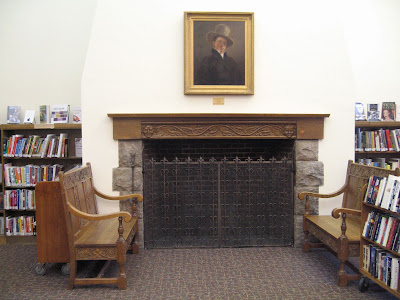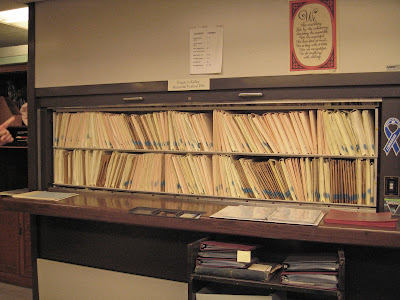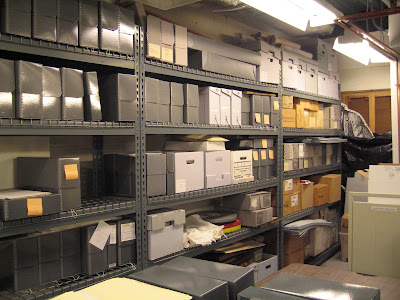Perhaps it was the setting (Cape May, gorgeous
weather). Maybe it was the wonderful Local Arrangements folks who were very
proud and knowledgeable of their local history. Or, it could have been the program and the
workshops. The winning combination of all of the above likely made the Spring MARAC (April 12-14) a success as an entertaining and educational conference.
Dating 19th
Century Portrait Photographs Workshop
One of my favorite parts of the
conference was Gary Saretsky’s Dating 19th Century Portrait
Photographs workshop on Thursday April 12. During his presentation, I felt as
if I were absorbing a semester’s worth of knowledge in an afternoon. In
addition to giving workshops, Gary is the Monmouth County Archivist, and Coordinator
of the Public History Internship Program for the Rutgers University-New
Brunswick History Department. He also is a fine photographer himself, with a
recent exhibit of blues performers at the Plainfield Public Library.
Gary’s workshop took its participants through the history
of early photographic portraiture from the earliest Daguerreotypes in 1839
through cabinet cards in the late 1800s-early 1900s. We learned the distinctive elements that help date Daguerreortypes, ambrotypes, tintypes (also
known as melainotypes and ferrotypes), cartes-de-visites, and cabinet cards. Gary
also provided us with resources for determining the dates of costumes in
photographs.
He brought many examples of cabinet cards and
earlier photographs, and invited us to try to identify them, using
what we had learned. I just wanted to buy a micrometer and attempt to identify
the cabinet cards (by thickness and other means) within the Plainfield Public
Library’s Local History collections. Overall, it was an inspiring, informative
workshop that was well worth the price of admission. If I were an archives
professor, I’d book Gary as a guest lecturer every semester.
Conference
Sessions
In the sessions I attended, I noticed a pattern
with some of the speakers – they were the users of archives and special
collections, rather than “us.” I was glad to hear how these professionals tied
the importance of archival collections to their work because they are our
patrons and researchers. They teach us how to best help them. Most also expressed their intense gratitude for the
work archivists and librarians do to make materials accessible in person and
especially online.
For example, the plenary speaker was historic
preservation consultant Joan Berkley, who spoke about the archival resources,
especially primary sources, she used to uncover the structural details of an historic
house museum. Importantly, she named all the repositories she used, and
explained how she used the archival materials in her work. Another session I
attended, on preserving and promoting New Jersey’s historic structures, also
featured three speakers who use archives and libraries to preserve historic
properties, the Doo Wop resort architecture of the Wildwoods, and lighthouses
in the state.
Additionally, the final session of the conference
featured the author of Boardwalk Empire,
Nelson Johnson, and a writer from the HBO series of the same name, Edward
McGinty. These two gentlemen talked about the value of archives and libraries
from two very different directions, but each made clear cases for the use of
primary sources whether digitized or not. The other two speakers of that
session, Heather Pérez and Shannon O’Neill of the Atlantic City Free Public
Library, talked at length about how the show has changed the way they do their
work and deliver their services to patrons.
In the sessions featuring archivists as speakers, there
were many standouts, including one focused on the Brooklyn Historical
Society's efforts to attract and educate students. It was inspiring to see
how dedicated the BHS is to its young student and undergraduate patrons. The
society has created a host of programs reaching from K-12 through
undergraduates. One example is the Young Curators program, which allows 4th
and 5th graders to construct their own meaning of history in a new and visual way. They do this by completing a 12-week residency program wherein they
create exhibit panels using the BHS’ archives to encourage further research,
and spotlight historical events and people. BHS' programs might be a bit
ambitious (and expensive) for the libraries where I work, but the depth and
breadth of their offerings are certainly well worth the funding the staff has
been able to secure for them.
Public Displays: Using Your Collection and
Archives to Tell Your Story was a session featuring three diverse views on
displays. First, a young researcher (Rachael Rohrbaugh of Chatham University)
talked about the results from her study on the lack of exhibits education in
MLIS/MLS programs. Next, a couple from the Cape May County Historical Society
(Bruce and Pary Lion Tell) showed us very economical and practical ways to set
up and display facsimiles of historic documents in exhibit cases. Finally, an
archivist I had seen at a previous MARAC, when she worked at the Andy Warhol
Museum (Amy Lucadamo, now of Wilson College), provided a variety of methods to
showcase collections. In particular, she focused on an innovative timeline she
created for alumni visitors – it connected images and icons of shared history
with individual histories of alumni. She also showed ways to spotlight objects
and records in nifty ways, such as magnifying text (a museum display
technique).
Finally, one of the most riveting speakers
was neither an archivist, nor historian. He was our host, Curtis Bradshaw, owner
of Congress Hall. Curtis is the grandson of Carl McIntire, a fiery
fundamentalist Presbyterian minister whose mammoth collection of papers and
audio records was recently processed by the Princeton Theological Seminary
(primarily by MARAC Program Commitee Co-chair Bob Golon). In the session
Rescuing and Making Available a Controversial Collection: The Carl McIntire
Papers at Princeton Theological Seminary, Kenneth Woodrow Henke, of PTS,
provided a lively history of McIntire. He also told us how the collection came to
PTS, then introduced Curtis, who shared his personal impressions of his
grandfather. Curtis told many stories of how his grandfather worked. For
example, he would watch his grandfather at the microphone, delivering his radio
sermons. He also directed groups of female volunteers to keep newspaper
clippings files (now at PTS) in order to save a record of his 20th century
reformation of the Presbyterian church. A charismatic speaker, Curtis kept his
audience amused, and gave us a peek into the famed minister’s life.
As always, MARAC exceeded my expectations and
left me with more knowledge and skills to take back to the
libraries where I work. To see the complete program, visit MARAC (downloads a
PDF). http://data.memberclicks.com/site/marac/Marac-2012-SpringProgram-4.pdf










